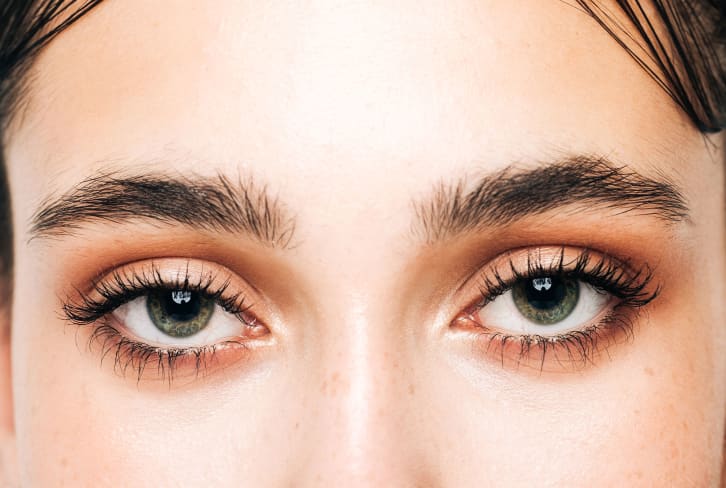Advertisement
Manicure At Home: A Step-By-Step Guide To A DIY Salon-Grade Mani

On the list of things we've had to table due to the ongoing COVID-19 quarantine? Manicures. If you want to attempt a salon-grade experience, it's actually much easier than you might think. Seriously, with a few steps, you can achieve a polished, clean look.
Now, if you were one to get gels, acrylic, or dip, we've discussed how to safely remove them at home and how to care for your nails back to health. So check those out if you need to have a rehab moment before you reach for the polish.
But if your nails are ready to go, here are our tips.
DIY salon-grade manicure.
Before you get started, you need to gather your materials. This includes polish of choice, base coat, top coat, file, buffer, some sort of cuticle pusher, trimmer, polish remover, and cotton pad (if you are wearing polish). If you don't have all of these at the ready, that's OK; we'll walk you through how to make do, but for a top-line experience, these are the tools:
Clean the nail.
Seems obvious but bears repeating: "You can't achieve a clean manicure if you have remnants of a past one. This will cause uneven lines. Now when you go about removing the polish, don't rub: Instead, saturate the cotton with nail polish remover, count to five, and pull forward, and nine times out of 10, the polish will come off completely,” says celebrity manicurist Deborah Lippmann.
Skip the soak.
Soaking the nail is actually not a vital part of the salon experience, so you can feel free to opt out in your at-home version. In fact, many manicurists avoid it on purpose: "When your nails are soaked in water, they expand," says manicurist and founder of Varnish Lane, Lauren Dunne. This distorts and widens the nail's shape; then, when you paint polish over the nail and it dries "[this causes] your polish to chip prematurely." (Soaking tends to be more important for pedicures as the water helps soften the thicker, coarser skin on the foot; it's just not as needed for your fingertips, which have more delicate skin anyway.)
Shape the nail.
There are plenty of nail shapes to choose from, but your safest bet is this: "It's best to shape the nail so it mirrors the shape of the cuticle, which elongates your fingers," says Lippmann. This will be your most natural-looking and pairs well with any color or finish.
To achieve this look, first trim the nail (if needed) so they are all the same length. Then, with your file, file in one direction: Start on one outside end and sweep toward the center; then flip to the other outer side and do the same. Do not use the "saw" motion as that can be too abrasive to weaker nails.
Tend to the cuticles.
"Then take your pusher and push your cuticle back toward the knuckle," says Lippmann. If you don't have a pusher, you can use a cotton swap or even the end of your file (wrap the end of the file with a tissue so the abrasive grains scrape against the nail as you push). "If you have a piece of skin that's still hanging after you've properly pushed it, you can take your cuticle nipper and just nip that tiny piece of skin. You never want to nip all the way around."
Follow up with a cuticle oil. Jojoba oil is nutrient-dense and fast-absorbing, but even a light, natural hair oil will do. "Barely dot it at the base of the nail, massaging into the cuticle," she says. Then follow with a hand cream to treat all of the skin (our frequently washed hands could likely use it).
Create a base.
First up, Lippmann notes, make sure your oil and hand creams are fully absorbed. The polish won't properly adhere to the nail if they are too oily. Then apply your base polish.
"The most important being your base coat because that is what is touching your nail and seeping into the skin," Nadine Abramcyk, co-founder of clean salon tenoverten tells us here. So even if you don't have a clean polish around the house (see our favorite clean polishes here if you're looking for some new options), do try to make sure you have at least a 7-free base polish.
Finish it up.
Grab your favorite polish, then follow this motion, from Lippmann: "Place the brush about an eighth-inch away from the cuticle. As soon as you see polish flow, pull the brush straight down the center to the tip. Your nails get a bit wider at the side, so apply a little more pressure and let the bristles fan out. The next thing is to cap the nail. To do this, take the very tip of your brush and swipe it across the very tip of your nail, and that will keep your polish on for days longer." Follow up with a top coat, let it dry, and your mani is good to go.
Mani aftercare.
Within at least the first hour of your at-home mani, try to avoid contact with water. This, of course, is easier said than done in our post-COVID-19 world in which we're all encouraged to wash our hands far more. But if you can help it, letting the polish full set for at least one hour will keep your polish in better condition for longer. This goes back to nails expanding in water: The stretching and contraction before polish truly hardens weakens the polish's grip on the nail.
For day-to-day care, just be sure to keep your hands moisturized with creams and apply a dab of cuticle oil daily. This will keep the skin and nail soft, rather than flaky and brittle. After a week of your mani, remove the polish to give your nails a breather. Then? Start this all over.
Watch Next
Enjoy some of our favorite clips from classes
Enjoy some of our favorite clips from classes
What Is Meditation?
Mindfulness/Spirituality | Light Watkins
Box Breathing
Mindfulness/Spirituality | Gwen Dittmar
What Breathwork Can Address
Mindfulness/Spirituality | Gwen Dittmar
The 8 Limbs of Yoga - What is Asana?
Yoga | Caley Alyssa
Two Standing Postures to Open Up Tight Hips
Yoga | Caley Alyssa
How Plants Can Optimize Athletic Performance
Nutrition | Rich Roll
What to Eat Before a Workout
Nutrition | Rich Roll
How Ayurveda Helps Us Navigate Modern Life
Nutrition | Sahara Rose
Messages About Love & Relationships
Love & Relationships | Esther Perel
Love Languages
Love & Relationships | Esther Perel

















